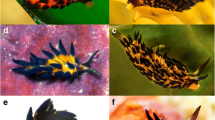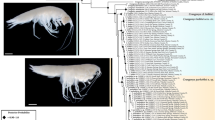Abstract
The discovery of a possibly invasive Proscoloplos species on the French Atlantic coast led to a detailed morphological and molecular investigation. Proscoloplos consists of three nominal species, but molecular analyses of the variable ITS1 and ITS2 region revealed no clade support for samples from South Africa, France and Australia, representing at least two of these nominal species. We found no unambiguous diagnostic characters for the three different species even with scanning electron microscopy. Two main characters—first appearance of branchiae and hooks—that were used for species delineation show considerable intrapopulational variation and do not withstand critical evaluation. The obtained data and the observed regenerative capabilities point to a cautious use of the position of branchiae and hooked chaetae as taxonomic marker in Proscoloplos. After experimental bisection of animals, the recovery led to a phenotype without recognizable signs of regeneration, but neither branchiae nor hooked chaetae reoccurred at the same initial segmental position. Summarising the molecular and morphological data we suggest the synonymy of the known Proscoloplos species under the senior synonym Proscoloplos cygnochaetus Day, 1967. The enormous geographic range of this species comprises the temperate waters of the whole southern hemisphere and includes the French population. We discuss a dispersal enabled through the effective anchorage on vessels using mucous glands and chaetae possibly combined with architomic reproduction.





Similar content being viewed by others
References
Bakker FT, Olsen JL, Stam WT, van den Hoek C (1992) Nuclear ribosomal DNA internal transcribed spacer regions (ITS1 and ITS2) define discrete biogeographic groups in Caldophora albida (Chlorophyta). J Phycol 28:839–845
Bastrop R, Juerss K, Sturmbauer C (1998) Cryptic species in a marine polychaete and their independent introduction from North America to Europe. Mol Biol Evol 15:97–103
Bell AW (1959) Enchytraeus fragmentosus, a new species of naturally fragmenting oligochaete worm. Science 129:1278
Bely A (1999) Decoupling of fission and regenerative capability in an asexual oligochaete. Hydrobiologia 406:243–251
Bely A (2006) Distribution of segment regeneration ability in the Annelida. Integr Comp Biol 46:508–518
Berrill NJ (1931) Regeneration in Sabella pavonina (Sav.) and other sabellid worms. J Exp Zool 58:495–523
Berrill NJ (1952) Regeneration and budding in worms. Biol Rev 27:401–38
Bleidorn C (2005) Phylogenetic relationships and evolution of Orbiniidae (Annelida, Polychaeta) based on molecular data. Zool J Linn Soc 144:59–73
Bleidorn C, Kruse I, Albrecht S, Bartolomaeus T (2006) Mitochondrial sequence data expose the putative cosmopolitan polychaete Scoloplos armiger (Annelida, Orbiniidae) as a species complex. BMC Evol Biol 6:47
Chen CA, Chen C-P, Fan T-Y, Yu J-K, Hsieh H-L (2002) Nucleotide sequences of ribosomal internal transcribed spacers and their utility in distinguishing closely related Perinereis polychaetes (Annelida; Polychaeta; Nereididae). Mar Biotech 4:17–29
Coulon J, Diano M, Arsanto J-P, Thouveny Y (1989) Remodeling processes during anterior regeneration of Owenia fusiformis (Polychaeta, Annelidae): a morphological and immunocytochemical survey. Can J Zool 67:994–1005
Dawson MN, Jacobs DK (2001) Molecular evidence for Cryptic species of Aurelia aurita (Cnidaria, Scyphozoa). Biol Bull 200:92–96
Day JH (1954) The polychaetes of Tristan da Cunha. Results Norw Sci Exped Tristan da Cunha 1937–1938 4:1–35
Day JH (1967) A monograph of the Polychaeta of Southern Africa. Part 2. Sedentaria. British Museum (Natural History), London
Dupin F, Coulon J, Le Parco Y, Fontes M, Thouveny Y (1991) Formation of the extracellular matrix during the epimorphic anterior regeneration of Owenia fusiformis: autoradiographical and in situ hybridization studies. Int J Dev Biol 35:109–19
Fritz GN, Conn J, Cockburn A, Seawright J (1994) Sequence analysis of the ribosomal DNA internal transcribed spacer 2 from a population of Anopheles nuneztovari (Diptera: Culicidae). Mol Biol Evol 11:406–416
Gamenick I, Abbiati M, Giere O (1998) Field distribution and sulphide tolerance of Capitella capitata (Annelida: Polychaeta) around shallow water hydrothermal vents off Milos (Aegean Sea). a new sibling species? Mar Biol 130:447–453
Gibson GD, Paterson IG (2003) Morphogenesis during sexual and asexual reproduction in Amphipolydora vestalis (Polychaeta: Spionidae). N Z J Mar Freshwater Res 37:741–52
Gómez A, Serra M, Carvalho GR, Lunt DH (2002) Speciation in ancient cryptic species complexes: evidence from the molecular phylogeny of Brachionus plicatilis (Rotifera). Evolution 56:1431–1444
Hall TA (1999) BioEdit: a user-friendly biological sequence alignment editor and analysis program for Windows 95/98/NT. Nucleic Acids Symp Ser 41:95–98
Hartmann-Schröder G (1962) Zweiter Beitrag zur Polychaetenfauna von Peru. Kieler Meeresforsch 18:109–147
Hartmann-Schröder G (1984) Teil 10.Die Polychaeten der antiborealen Südküste Australiens (zwischen Albany im Westen und Ceduna im Osten). In: Hartmann-Schröder G, Hartmann G (eds) Zur Kenntnis des Eulitorals der australischen Küsten unter besonderer Berücksichtigung der Polychaeten und Ostracoden. Mitteilungen aus dem Hamburgischen Zoologischen Museum und Institut 81, Hamburg, pp 7–62
Hartmann-Schröder G (1986) Teil 12.Die Polychaeten der antiborealen Südküste Australiens (zwischen Wallaroo im Westen und Port MacDonnell im Osten). In: Hartmann-Schröder G, Hartmann G (eds) Zur Kenntnis des Eulitorals der australischen Küsten unter besonderer Berücksichtigung der Polychaeten und Ostracoden. Mitteilungen aus dem Hamburgischen Zoologischen Museum und Institut 83, Hamburg, pp 31–70
Hartmann-Schröder G (1987) Teil 13.Die Polychaeten der antiborealen Küste von Victoria (Australien) (zwischen Warrnambool im Westen und Port Welshpool im Osten). In: Hartmann-Schröder G, Hartmann G (eds) Zur Kenntnis des Eulitorals der australischen Küsten unter besonderer Berücksichtigung der Polychaeten und Ostracoden. Mitteilungen aus dem Hamburgischen Zoologischen Museum und Institut 84, Hamburg, pp 27–66
Hartmann-Schröder G (1989) Teil 14. Die Polychaeten der antiborealen und subtropisch-tropischen Küste Südost-Australiens zwischen Lakes Entrance (Victoria) im Süden und MacLean (New South Wales) im Norden. In: Hartmann-Schröder G, Hartmann G (eds) Zur Kenntnis des Eulitorals der australischen Küsten unter besonderer Berücksichtigung der Polychaeten und Ostracoden. Mitteilungen aus dem Hamburgischen Zoologischen Museum und Institut 86, Hamburg, pp 11–63
Heads M (2005) Towards a panbiogeography of the seas. Biol J Linn Soc Lond 84:675–723
Hewitt CL (2002) The distribution and diversity of tropical australian marine bio-invasions. Pac Sci 56:213–222
Kelaher BP, Rouse GW (2003) The role of colonization in determining spatial patterns of Proscoloplos bondi sp. nov. (Orbiniidae: Annelida) in coralline algal turf. Mar Biol 143:909–917
Klautau M, Russo CAM, Lazoski C, Boury-Esnault N, Thorpe JP, Solé-Cava AM (1999) Does cosmopolitanism result from overconservative systematics? a case study using the marine sponge Chondrilla nucula. Evolution 53:1414–1422
Knowlton N (2000) Molecular genetic analyses of species boundaries in the sea. In: Thorpe JP (eds) Marine genetics. Kluwer, Dordrecht, pp 73–90
Kooistra WHCF, Stam WT, Olsen JL, van den Hoek C (1992) Biogeography of Cladophoropsis membranacea (Chlorophyta) based on comparisons of nuclear rDNA ITS sequences. J Phycol 28:660–668
Kumar S, Tamura K, Jakobsen IB, Nei M (2004) MEGA3: integrated software for molecular evolutionary genetics analysis and sequence alignment. Brief Bioinform 5:150–163
Kyle CJ, Boulding EG (2000) Comparative population genetic structure of marine gastropods (Littorina spp.) with and without pelagic larval dispersal. Mar Biol 137:835–845
Lee SB, Taylor JW (1992) Phylogeny of five fungus-like protoctistan Phytophora species, inferred from the internal transcribed spacers of ribosomal DNA. Mol Biol Evol 9:636–653
Liao D (1999) Concerted evolution: molecular mechanisms and biological implications. Am J Hum Genet 64:24–30
Lindsay SM, Jackson JL, He SQ (2006) Anterior regeneration in the spionid polychaetes Pygospio elegans and Dipolydora quadrilobata. Mar Biol DOI10.1007/s00227-006-0431-0
Márquez LM, Miller DJ, MacKenzie JB, van Oppen MJH (2003) Pseudogenes contribute to the extreme diversity of nuclear ribosomal DNA in the hard coral Acropora. Mol Biol Evol 20:1077–1086
Modrich P, Lahue R (1996) Mismatch repair in replication fidelity, genetic recombination, and cancer biology. Ann Rev Biochem 65:101–133
Morgan JAR, Blair D (1998) Trematode and monogenean rRNA ITS2 secondary structure support a four-domain model. J Mol Evol 47:406–419
Müller MCM (2004) Nerve development, growth and differentiation during regeneration in Enchytraeus fragmentosus and Stylaria lacustris (Oligochaeta). Dev Growth Differ 46:471–8
Myohara M, Yoshida-Noro C, Kobari F, Tochinai S (1999) Fragmenting oligochaete Enchytraeus japonensis: a new material for regeneration study. Dev Growth Differ 41:549–55
Okada YK (1934) Regeneration de la tete de Myxicola aesthetica (Clap.). Bull Biol Fr Belg 68:340–81
Patti FP, Gambi MC (2001) Phylogeography of the invasive polychaete Sabella spallanzanii (Sabellidae) based on the nucleotide sequence of internal transcribed spacer 2 (ITS2) of nuclear rDNA. Mar Ecol Prog Ser 215:169–177
Pleijel F, Rouse GW (2005) A revision of Micropodarke (Psamathini, Hesionidae, Polychaeta). J Nat Hist 39:1313–1325
Posada D, Buckley TR (2004) Model selection and model averaging in phylogenetics: advantages of Akaike Information criterion and Bayesian approaches over likelihood ratio tests. Syst Biol 53:793–808
Posada D, Crandall KA (2001) Selecting the best-fit model of nucleotid substitution. Syst Biol 50:580–601
Sayles LP (1932) External features of regeneration in Clymenella torquata. J Exp Zool 62:237–57
Sayles LP (1936) Regeneration in the polychaete Clymenella torquata. III. effects of level of cut on type of new structures in anterior regeneration. Biol Bull Woods Hole 70:441–59
Schröder PC, Hermans CO (1975) Annelida: Polychaeta. In: Giese AC, Pearse JS (eds) Reproduction of marine invertebrates III. Annelids and echiurans. Academic Press, New York, pp 1–213
Shimodaira H (2002) An approximately unbiased test of phylogenetic tree selection. Syst Biol 51:492–508
Shimodaira H, Hasegawa M (2001) CONSEL: for assessing the confidence of phylogenetic tree selection. Bioinformatics 17:1246–1247
Solis-Weiss V, Fauchald K (1989) Orbiniidae (Annelida: Polychaeta) from mangrove root-mats in Belize, with a revision of protoariciin genera. Proc Biol Soc Wash 102:772–792
SPSS Inc. (2000). Statistical package for the social sciences. http://www.spss.com
Swofford DL (2002) PAUP*. Phylogenetic analysis using parsimony, version 4.0b8. Sinauer, Sunderland
Thompson JD, Higgins DG, Gibson TJ (1994) CLUSTAL W: improving the sensivity of progressive multiple sequence alignment through sequence weighting, position specific gap penalties and weight matrix choice. Nucleic Acids Res 22:4673–4680
van Oppen MJH, Willis B, van Rheede T, Miller DJ (2002) Spawning times, reproductive compatibilities and genetic structuring in the Acropora aspera group: evidence for natural hybridization and semi-permeable species boundaries in corals. Mol Ecol 11:1363–1376
Vollmer SV, Palumbi SR (2004) Testing the utility of internally transcribed spacer sequences in coral phylogenetics. Mol Ecol 13:2763–2772
Westheide W, Hass-Cordes (2001) E Molecular taxonomy: description of a cryptic Petitia species (Polychaeta: Syllidae) from the island of Mahé (Seychelles, Indian Ocean) using RAPD markers and ITS2 sequences. J Zool Syst Evol Res 39:103–111
Westheide W, Hass-Cordes E, Krabusch M, Müller M (2003) Ctenodrilus serratus (Polychaeta: Ctenodrilidae) is a truly amphi-atlantic meiofauna species—evidence from molecular data. Mar Biol 142:637–642
Westheide W, Schmidt H (2003) Cosmopolitan versus cryptic meiofaunal polychaete species: an approach to a molecular taxonomy. Helgol Mar Res 57:1–6
Wilson WHJ (1979) Community structure and species diversity of the sedimentary reefs constructed by Petaloproctus socialis (Polychaeta: Maldanidae). J Mar Res 37:623–42
Yu ET, Juinio-Meñez A, Monje VD (2000) Sequence variation in the ribosomal DNA internal transcribed spacer of Tridacna crocea. Mar Biotechnol 2:511–516
Acknowledgments
We gratefully acknowledge the Natural History Museum of London and the Zoologisches Museum der Universität Hamburg for the loan of specimens. We thank the staff of the Station Biologique de Roscoff for providing working facilities. We are indebted to Thomas Bartolomaeus (Free University of Berlin) for support and discussion of this project.
We thank the reviewers for helpful comments and E. Griebeler for support with the statistical framework.
Author information
Authors and Affiliations
Corresponding author
Additional information
Communicated by M. Wahl.
Rights and permissions
About this article
Cite this article
Meyer, A., Bleidorn, C., Rouse, G.W. et al. Morphological and molecular data suggest a cosmopolitan distribution of the polychaete Proscoloplos cygnochaetus Day, 1954 (Annelida, Orbiniidae). Mar Biol 153, 879–889 (2008). https://doi.org/10.1007/s00227-007-0860-4
Received:
Accepted:
Published:
Issue Date:
DOI: https://doi.org/10.1007/s00227-007-0860-4




